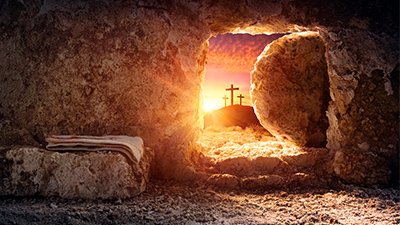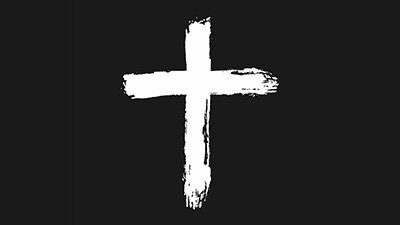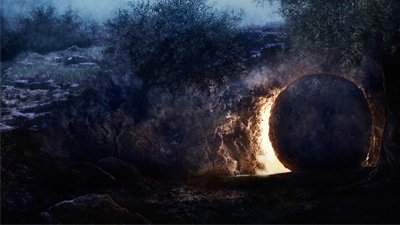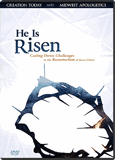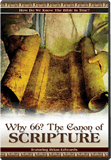
A Matter of Days?
If Jesus was in the grave for three days and three nights, then how could He have been crucified on Friday? Paul Taylor, AiG–U.K., and Bodie Hodge, AiG–U.S., examine the issue.
This would be a criticism of Paul Taylor’s Ch. 27 in The New Answers Book 2 regarding fitting the “three days and three nights” [of Jesus’ grave time] between Good Friday and Easter Sunday. Question: Why would he [rightly] regard the six days of creation as six 24-hour days, and NOT regard the three days and three nights as three literal 24-hour days? Answer: Because he has to get into a “counting” exercise when starting from the church (read: man-made) tradition of a Good Friday crucifixion, as opposed to a strict biblical reading as in John 19:31. The Thursday in Taylor’s reporting was actually a “high day” [Sabbath] or Passover (v. 14) and that is why they were hurrying to get Jesus into the tomb before it commenced at 6 p.m. or the late hours at the end of Wednesday; ergo Jesus’ crucifixion on Wednesday afternoon at about 3 p.m. (or the 9th hour). When reckoned thusly, a full three days and three nights fits exactly prior to Sunday or the first day of the week. Respectfully. . .
–R.M., U.S.
Learning Again
I’ve been visiting this website since May, and I think think it’s awesome. I’ve never been an evolutionist but felt that I couldn’t argue against secular ideas about the fossil record, big bang, etc. because the science behind it seemed valid. Nobody I knew, not even people at church, explicitly supported 6 day creation(!); I just didn’t feel that “the Bible is not a science textbook” or “Genesis 1-2 should be read as poetry” responses satisfied me.
I cannot thank you enough for putting together this giant resource so that I could look up any issue (i.e., C-14 dating, ice ages, memes. . .) and get very satisfactory answers. It wasn’t until I learned that I can trust the Bible’s historical accounts that my faith, history, science, morals made sense. As I’m learning to become a high school teacher, I’m learning secular origins theories all over again. Thanks to you, I’m learning where these theories come from and how to respond intelligently.
Praise God!
—C.T., Canada
More to Come
How exciting to see the Creation Museum take advantage of and promote so many neat Fall activities. Makes me wish I lived close enough to come every week. (Unfortunately we live about 3 hours away.) But still . . . how exciting! It’s like I can’t wait to see what you guys will come up with next . . . so many possibilities!!
Praying that in the midst of persecution (from without and within) that you, your staff, and family will have the grace of God as a cloak about you.
—C.K., U.S.
Tell-tale Sign
I couldn’t find a proper place to say this, but you’ve got a wonderful website going. I design websites, [and] am also an avid creationist and teach creation science at one of our local Bible schools. I am sick in bed today and was looking for something interesting to read and videos to watch. [AiG] is a great source of information. Thanks again for a great website, the tell-tale sign of a great ministry.
—P.J., South Africa
Have Something to Add?
Let us know what you think.
Many thanks for your email. We are aware of the issue that you raise, and we hope you will accept that it is an issue which we have thought through very carefully. There are all sorts of difficulties with determining the dates of the crucifixion, and we would certainly not want to insist on Jesus’s crucifixion being on a Friday for traditional reasons—but rather, for biblical reasons—and our hope here is to explain this in more detail. However, we are not being dogmatic about such a stance either.
For many years, one author of this response/feedback held to the view similar to that which you have expressed. However, Scripture is actually silent on there being an “extra” Sabbath at the time of Jesus’s crucifixion. The text says:
John 19:31
Therefore, because it was the Preparation Day, that the bodies should not remain on the cross on the Sabbath (for that Sabbath was a high day), the Jews asked Pilate that their legs might be broken, and that they might be taken away.
This is not to be confused with the “High Sabbath” in John 19:31, which is a Sabbath that falls during the Passover week or other Jewish festivals. Jesus died the day before the Sabbath, i.e. the Preparation Day (Mark 15:42), and was placed in the tomb on the Preparation Day (John 19:14, 42).
This Preparation Day happened to be the first day of Passover as well. Therefore, a more plain reading of the texts suggests that Jesus was indeed crucified on the day before the Sabbath, i.e. Friday. We think this is as plain an indication as we can get that the traditional timescale is, in fact, the biblical timescale, seeing that the English word/equivalent Friday could not be used. However, there should be no disagreement that Jesus rose on the first day of the week, i.e. Sunday (Mark 16:9; Luke 24:1).
Some have suggested alternative timings that “allow” Jesus to have died on the Wednesday or Thursday rather than the Friday. Holders of such a position have sometimes criticized the Friday–Sunday position as following a “tradition” of men rather than Scripture, since the Scripture does not explicitly say that Jesus died on a “Friday.”
However, to have Jesus dying on a Wednesday requires the postulation of an extra Sabbath day on the Thursday, though nothing is mentioned in the Gospels. There is nothing in the text that leads us necessarily to suspect that the Sabbath was anything other than the regular Day Seven Sabbath. We want to emphasize that this is not, to us, a major point of doctrinal concern. The “Special Sabbath” analysis is certainly a valid analysis, maintained by people whose commitment to the authority of Scripture is sound. We would want to maintain that our own timescale is scripturally sound—and we believe it is to be preferred, as it does not require assumptions extra to the text.
Some have tried to push for an extra Sabbath by appealing to John 18:28, saying the Jews were looking to celebrate the Passover after Jesus was crucified. A friend suggested to us:
In light of John 18:28, this would seem to indicate a Thursday crucifixion. This verse seems to indicate that the Jewish leaders were planning to celebrate the Passover following the crucifixion of Jesus—the next day, which began 3 hours after His death.”
A major problem appears with the Thursday crucifixion scenario by appealing to the fact that Jewish leaders wanting to eat the Passover after Christ’s death—that would be saying that Jesus didn’t eat the Passover on the correct day, since He ate the evening before. It is true that they were planning on eating the Passover at a later time, but not the next day. John 18:28, is indicating they were wanting eat later that day, which was still the same day Jesus ate, but Jesus ate at the beginning of the day (evening in the Jewish calendar), whereas the others were wanting to eat later in the day (probably the afternoon).
Sir Robert Anderson in The Coming Prince calculated which days would have been Passovers for various years.1 For example, AD 30 was a Thursday, AD 31 was Tuesday, AD 32 was a Monday, AD 33 was a Friday, AD 34 was a Tuesday, AD 35 was a Monday, and AD 36 was a Friday.
For a Wednesday Passover, one would need to go to AD 27, as this is the closest year. One thing that seems overlooked too often is that John 2:20 establishes that Jesus’s first Passover while He was in public ministry (AD 30) was 46 years after Herod began building the temple in 17 BC. Jesus celebrated two more Passovers (John 5:1; John 6:4), then the next Passover was His crucifixion, most likely AD 33, which occurred on a Friday. So, the beginning of the Jewish Friday (which is Thursday evening for most of us) is when Jesus ate the Passover—then was betrayed, beaten, put on trial, and ultimately crucified. This occurred on the Preparation Day, which was also the Passover that year and immediately before the Sabbath—a High Sabbath because it fell during Passover week.
Significance of the Passover
God has always been very strict about the Passover. When the firstborn of Egypt were struck down, the Lord gave specific instructions that were to be followed to the letter by the Israelites in Exodus 12. Throughout Israelite history, the Passover was among the most honored and sacred times of sacrifice. Recall that even Jesus, during His recorded three prior years of ministry, diligently kept Passovers (John 2:13; John 5:1; John 6:4). Even Jesus’s parents celebrated the Passover each year (Luke 2:41).
It seems likely that Jesus, who is the ultimate sacrificial Lamb, would be sacrificed on the Passover, especially considering that God to be so strict with the Israelites to perform sacrifices on the Passover:
1 Corinthians 5:7
Therefore purge out the old leaven, that you may be a new lump, since you truly are unleavened. For indeed Christ, our Passover, was sacrificed for us.
Matthew 26:2
You know that after two days is the Passover, and the Son of Man will be delivered up to be crucified.
Such verses lead to the conclusion that Jesus was sacrificed later on the same day that He ate the Passover. The great scholar Archbishop James Ussher affirmed that Jesus was crucified on the Passover.2
“Three Days and Three Nights” or “The Third Day”?
This leads us to the problem of reconciliation with the counting of “three days and three nights.” Yet, we have clear biblical evidence from the book of Esther that the biblical method of counting was not the same as our Western method. The table which we drew up for NAB2 illustrates this.
Scripture needs to interpret Scripture within the relative context and culture. Old Testament Jewish culture equates “Three days and three nights” with “on the third day.” The scriptural basis for this was established previously in the chapter in NAB2. Consider an example in Esther:
Esther 4:16
“Go, gather all the Jews who are present in Shushan, and fast for me; neither eat nor drink for three days, night or day. My maids and I will fast likewise. And so I will go to the king, which is against the law; and if I perish, I perish!”
Now, if the days and nights were counted in a Western way, this would result in Esther going to see the King on the fourth day. However, this is what we actually read:
Esther 5:1
Now it happened on the third day that Esther put on her royal robes and stood in the inner court of the king’s palace, across from the king’s house, while the king sat on his royal throne in the royal house, facing the entrance of the house.
Another example can be found in Samuel:
1 Samuel 30:12–13
12 And they gave him a piece of a cake of figs and two clusters of raisins. So when he had eaten, his strength came back to him; for he had eaten no bread nor drunk water for three days and three nights.
13 Then David said to him, “To whom do you belong, and where are you from?” And he said, “I am a young man from Egypt, servant of an Amalekite; and my master left me behind, because three days ago I fell sick.”
There are other examples, with other numbers besides three, but this should suffice. This teaching is reinforced in the New Testament Jewish culture as well:
Matthew 27:63–64
63 saying, “Sir, we remember, while He was still alive, how that deceiver said, ‘After three days I will rise.’
64 “Therefore command that the tomb be made secure until the third day, lest His disciples come by night and steal Him away, and say to the people, ‘He has risen from the dead.’ So the last deception will be worse than the first.”
The above example is particularly pertinent. If the Chief Priests and Pharisees had counted in the Western fashion, they would surely have wanted the tomb to be made secure until the beginning of the fourth day, especially since they are referring to the danger of Jesus’ body being stolen “by night.”3
If one looks up the many passages of Christ’s death, one would find both instances of three days and three nights (Matthew 12:40) and on the third day (Luke 24:46), or even in reference to raising the temple in three days (Mark 15:29; Luke 2:46).
Church Fathers Equate Three Days with Three Days and Three Nights
Both Ignatius, John the Apostle’s disciple, and the early Church Father Irenaeus equated three days with three days and three nights:
He also rose again in three days, the Father raising Him up; and after spending forty days with the apostles, He was received up to the Father, and “sat down at His right hand, expecting till His enemies are placed under His feet.” On the day of the preparation, then, at the third hour, He received the sentence from Pilate, the Father permitting that to happen; at the sixth hour He was crucified; at the ninth hour He gave up the ghost; and before sunset He was buried. During the Sabbath He continued under the earth in the tomb in which Joseph of Arimathaea had laid Him. At the dawning of the Lord’s day He arose from the dead, according to what was spoken by Himself, “As Jonah was three days and three nights in the whale’s belly, so shall the Son of man also be three days and three nights in the heart of the earth.” The day of the preparation, then, comprises the passion; the Sabbath embraces the burial; the Lord’s Day contains the resurrection.4
And the Lord Himself says, “As Jonas remained three days and three nights in the whale’s belly, so shall the Son of man be in the heart of the earth.” Then also the apostle says, “But when He ascended, what is it but that He also descended into the lower parts of the earth?” This, too, David says when prophesying of Him, “And thou hast delivered my soul from the nethermost hell”; and on His rising again the third day, He said to Mary, who was the first to see and to worship Him, “Touch Me not, for I have not yet ascended to the Father; but go to the disciples, and say unto them, I ascend unto My Father, and unto your Father.”5
Conclusion
Because of the lack of clarity in the text on the actual day of Jesus’s crucifixion, we would not want to “start a new church over this issue.” We hope you will accept that AiG’s view, as expressed in NAB2, represents a conservative evangelical interpretation of Scripture—in the same way that we accept that your interpretation is a completely valid conservative evangelical interpretation. And as always, we want to encourage deeper study into the Scriptures. It is good to endeavor to be consistent in our use of counting the days, but due to the passages in Esther, Samuel, and Matthew and other reason outlined, we would lean toward the Friday–Sunday interpretation.
With kindness in Christ,
Paul Taylor
Bodie Hodge
Footnotes
- As indicated by Larry Pierce in James Ussher, The Annals of the World, translated by Larry and Marion Pierce, second printing (Green Forest, Arkansas: Master Books, December 2003), page 822.
- James Ussher, The Annals of the World, translated by Larry and Marion Pierce, second printing (Green Forest, Arkansas: Master Books, December 2003), page 815.
- It is true that this was stated the following day after the Crucifixion, but the point is that the two phrases are being used almost interchangeably. We are not certain if this is in reference to the three days from when they say this or if they were looking back. Regardless, it was under guard when Christ arose.
- Ignatius, The Epistle of Ignatius to the Trallians, Chapter 9, Reference to the history of Christ, Longer Version.
- Irenaeus, Against Heresies, Book 5, Chapter 31. The preservation of our bodies is confirmed by the resurrection and ascension of Christ: the souls of the saints during the intermediate period are in a state of expectation of that time when they shall receive their perfect and consummated glory.
Recommended Resources

Answers in Genesis is an apologetics ministry, dedicated to helping Christians defend their faith and proclaim the good news of Jesus Christ.
- Customer Service 800.778.3390
- © 2024 Answers in Genesis

